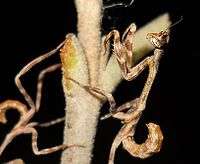Phyllovates chlorophaea
Phyllovates chlorophaea,[1] with the common name Texas unicorn mantis, is a species of praying mantis.
| Phyllovates chlorophaea | |
|---|---|
_(10-30-2015)_national_butterfly_center%2C_mission%2C_hidallgo_co%2C_tx_-03_(22520228644).jpg) | |
| Scientific classification | |
| Kingdom: | |
| Phylum: | |
| Class: | |
| Order: | |
| Family: | |
| Genus: | |
| Species: | P. chlorophaea |
| Binomial name | |
| Phyllovates chlorophaea (Blanchard, 1836) | |

It is native to the Southern United States, Mexico, Central America, and northern South America.
Background
Specimens in the United States are presently only known from southernmost Texas. The Florida record from Blatchley, 1920 is the only known record and has never been substantiated. Also, this species was described by Blanchard in 1836, not Blatchley, nearly a hundred years later.
Nymphs are handsome, brown-striped creatures that arise from small, globular oothecae that are reddish brown in color. The horn on the head is formed of two pieces and is very small in the early instars at first, looking like two knobs in 1st instar. As specimens grow, they overlap and appear to be a single large, horn though they are not fused. The adults are not so cryptic and have bright green wings with dark brown splotches. Females form four to ten oothecae, usually on thin branches. These hatch in approximately six weeks and contain thirty to fifty eggs per ootheca. There is no ootheca diapause.
See also
References
- Blanchard, 1836
- USA Mantis
- Dichotomous Key to Species of Mantids that may occur in Florida Blanchard listing is correct, scientific name is spelled wrong, and Blatchley reference is to finding this species in Florida, not description or year.
- Mantodea Species File Phyllovates chlorophaea page.